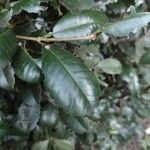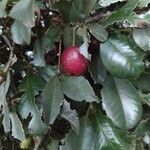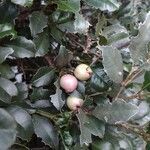Large shrub or small tree to c. 10 m high; bark smooth, light grey; pneumatophores 0. Branchlets ± pendent, angular. Lvs aromatic when crushed; petiole < 10 mm long. Lamina mostly 4-10-(13) × 1-3.5-(4) cm, sometimes smaller near base of branchlets and below infl., often narrowly elliptic, sometimes elliptic or obovate, glossy, slightly undulate; veins numerous, conspicuous and parallel; base attenuate or narrowly cuneate; apex mostly cuspidate to acuminate, but sharply acute in obovate lvs. Cymes with 3-25 fls, terminal or in the upper axils of short leafy branchlets, to c. 15 cm diam.; peduncles to c. 4 cm long; pedicels shorter, slender, angular. Hypanthium 4-6 mm long at anthesis, obconic, generally dark red at least on exposed side; pseudopedicel hardly evident; calyx lobes 2-4 mm long, broadly triangular-ovate, sometimes dark red, persistent on fr. Petals c. 4 mm diam., free, suborbicular, white, caducous. Stamens to c. 13 mm long, white. Style ± = longest stamens. Fr. 1-2-(2.5) × 0.7-1.5-(2) cm, oblong to obovoid, crimson to crimson-purple, ± glossy. Seed 1 or few, large; cotyledons green.
More
A tree up to 10 m tall and a spread of 5 m. In warm rainforest areas it can grow to 30 m tall. It has a dense crown of leaves. The stem is erect and stout with spreading branches. The leaves are rounded and 9 cm long by 3 cm wide. They are shiny green on the upper surface and paler underneath. New growth is bronze/red. The flowers are small, fluffy and white or cream. They are produced in small clusters in the angles of the upper leaves. The fruit can be rounded or oval. They are pink to dark red in colour and 2 cm across. The fruit are edible. They contain 1 seed.
A tropical plant. It grows in coastal regions and rainforest areas in north and eastern Australia. They will grow on a variety of soils. They need to be well drained. It does best if soils are humus rich. They can be grown in temperate regions and can withstand moderate frost. It is damaged by drought. It can grow in slight shade or full sun. In the Cairns Botanical Gardens. Adelaide Botanical Gardens. It suits hardiness zones 9-12. Arboretum Tasmania.
More
Grows in all types of warmer rainforest, often along streams, usually in coastal districts.
Along the coast and adjacent plateaux.
The fruit are eaten raw. It can be cooked. They can be used for jelly, syrups, preserves, or baked in pies and tarts. They are also used for drinks. The seeds can be roasted and eaten.



